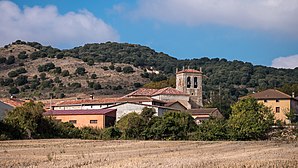Santa Olalla de Bureba
| Santa Olalla de Bureba parish | ||
|---|---|---|
 Santa Olalla de Bureba - town view
|
||
| coat of arms | Map of Spain | |

|
|
|
| Basic data | ||
| Autonomous Community : |
|
|
| Province : | Burgos | |
| Comarca : | La Bureba | |
| Coordinates | 42 ° 29 ′ N , 3 ° 26 ′ W | |
| Height : | 855 msnm | |
| Area : | 10.74 km² | |
| Residents : | 35 (Jan. 1, 2019) | |
| Population density : | 3.26 inhabitants / km² | |
| Postal code : | 09292 | |
| Municipality number ( INE ): | 09354 | |
| administration | ||
| Website : | Santa Olalla de Bureba | |
Santa Olalla de Bureba is a town in northern Spain and a rural municipality ( municipio ) with only 35 inhabitants (as of January 1, 2019) in the province of Burgos in the autonomous community of Castile-León . The municipality belongs to the poorly populated Serranía Celtibérica .
Location and climate
The town of Santa Olalla de Bureba is located on the northwest bank of the Rio Cerratón , a tributary of the Rio Oca , in the southwest of the La Bureba region at an altitude of about 855 m . The provincial capital, Burgos , is about 30 km (driving distance) to the southwest; Briviesca , the capital of the region, is a good 14 km northeast. The climate in winter is harsh, but in summer it is temperate and warm; the rain, which is sufficient for Spanish conditions (approx. 650 mm / year), falls mainly in the winter half-year.
Population development
| year | 1857 | 1900 | 1950 | 2000 | 2017 |
| Residents | 247 | 228 | 229 | 37 | 38 |
The mechanization of agriculture and the closure of smaller farms have led to a loss of jobs and thus to a migration of people to the larger cities ( rural exodus ) since the middle of the 20th century .
economy
For centuries, the inhabitants of the community lived mainly from agriculture (agriculture, viticulture and small livestock farming) as a self-sufficient living ; only since the middle of the 20th century has it been produced for the national market. Tourism in the form of rental of holiday homes (casas rurales) has also played a certain role in the municipality's income since the 1960s.
history
The landscape of the Bureba was already known to the people of the Stone Age and ancient times as a much-used connecting route; Celts from the tribe of the Autrigones settled here and the Romans called their later settlement near the present-day Monasterio de Rodilla Tritium Autrigonum . In the 8th and early 9th centuries, the area was under Islamic influence, but the area was neither permanently settled nor defended by the Berbers due to the unusually harsh and rainy climate . At the end of the 9th century, the Castilian Count Diego Rodríguez Porcelos received from King Alfons III. of Asturias the order to repopulate ( repoblación ) the depopulated area. The town was founded at this time and was first mentioned in a document in 1011. In 1146 King Alfonso VII granted the place numerous rights and privileges ( fueros ) .
Attractions
- The single-aisled Iglesia de Santa Olalla , constructed from precisely hewn stones, is St. Dedicated to Eulalia of Mérida . It dates from the 16th century, which is particularly evident in the Renaissance portal. The lighter rows of stones below the eaves suggest a change in plan or a later elevation of the structure. The corners of the church are stabilized by buttresses ; the apse has a flat end.
- In a small square behind the church there is a fountain (fuente) with a basin border. This was used for washing the laundry (lavadero) but also as a drinking trough (Abrevadero) .
Web links
- Santa Olalla de Bureba - Photos + Info (Spanish)
Individual evidence
- ↑ Cifras oficiales de población resultantes de la revisión del Padrón municipal a 1 de enero . Population statistics from the Instituto Nacional de Estadística (population update).
- ↑ Santa Olalla de Bureba - climate tables
- ↑ Santa Olalla de Bureba - population development
- ↑ Santa Olalla de Bureba - History

